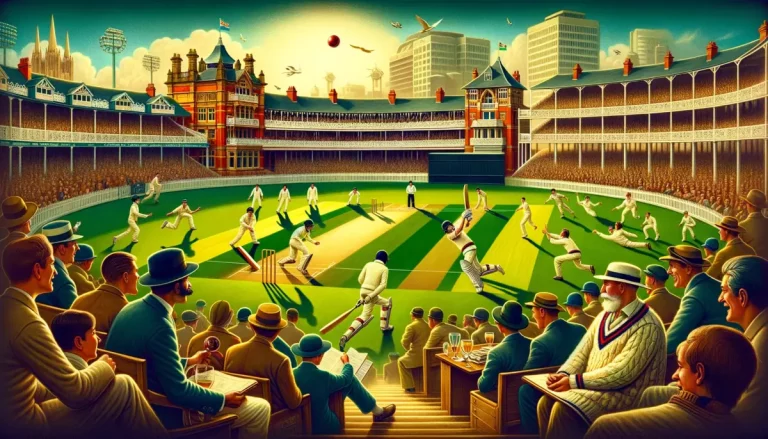5 Ways British Colonialism Shaped Cricket
5 Ways British Colonialism Shaped Cricket – Cricket’s emergence and early development was deeply shaped by British colonialism.
The British Empire spread the sport extensively by introducing it in colonies such as India, Australia, and the Caribbean.
Claim up to ₹15,000 Welcome Bonus Now
Claim up to ₹15,000 Welcome Bonus Now
- UPI, Paytm, gPay & PhonePe withdrawals
- The Biggest Bonuses in India
- 300% Welcome Bonus up to ₹10,000
Colonial schools and clubs served as institutions promoting cricket’s development and Anglo-centric culture.
The need for standard rules and organizational structures often came from colonial administrators. Cricket also reflected the unequal power dynamics of empire, though colonized peoples later asserted their excellence at the game.
Article Highlights
Hide- Cricket was introduced to diverse cultures and communities through British colonialism.
- British colonialism led to the construction of cricket stadiums and the establishment of cricket clubs as hubs for enthusiasts.
- British colonialism influenced the evolution of cricket techniques and the establishment of standardized rules and regulations.
- Cricket became a symbol of national pride and identity, reflecting the nation's character and values.
The enduring legacy is visible through global cricket’s governance still centered around former British colonies.
Examining cricket’s colonial roots provides insight, not accusation, but understanding of the cross-cultural exchanges that shaped the game.
With nuance, we can acknowledge unjust aspects while appreciating how colonized people found expression through cricket passions. This complex history informs the state of cricket today.
Introduction to British Colonialism and Cricket

Intertwined through the annals of history, British colonialism established a profound foundation for the development and global expansion of cricket.
The origins of cricket can be traced back to 16th-century England, where it was a popular pastime among the British elite.
As the British Empire began its expansion across the globe, so did the influence of cricket. British colonizers brought the sport with them to the various regions they occupied, introducing it to diverse cultures and communities. The British influence on cricket manifested in several ways.
Firstly, the colonial administration actively promoted the sport, establishing cricket clubs and organizing matches, which helped in its dissemination. These clubs became social hubs, bringing together British officials, local elites, and aspiring players.
The Ashes Series: 5 Key Moments in History
The Ashes Series: 5 Key Moments in History – The historic Ashes series between England and ... Read More
Secondly, the British colonial presence provided the necessary infrastructure for cricket to flourish. Cricket grounds, stadiums, and pitches were constructed, creating spaces for formal matches and training.
Furthermore, British colonialism facilitated the spread of cricket beyond its shores. As the British Empire expanded, so did the reach of the sport.
It became a means of cultural exchange and assimilation between the colonizers and the colonized. Native populations started adopting cricket, and it became a symbol of social mobility and prestige.
Spread of Cricket Through British Empire
The spread of cricket throughout the British Empire was extensive, reaching numerous regions and communities under British colonial rule.
While cricket became immensely popular in the colonies, its influence also extended beyond the boundaries of British control.
The game’s popularity in non-colonized countries, such as the United States, Canada, and the Netherlands, can be attributed to the British Empire’s global reach.
The British Empire’s influence on cricket terminology is another significant aspect of its spread. The terminology used in cricket, including terms like ‘wicket,’ ‘bowler,’ and ‘innings,’ all originated from British colonial influence.
These terms were adopted by cricket-playing nations, both within and outside the empire, and continue to be used today.
Furthermore, the British Empire’s establishment of cricket clubs in various regions played a crucial role in spreading the game.
These clubs served as hubs for cricket enthusiasts, providing them with facilities and resources necessary for the game’s practice and development.
As a result, cricket gained popularity not only among the British colonial population but also among local communities who embraced the sport.
Development of Cricket Infrastructure
Cricket infrastructure underwent significant development under the influence of British colonialism. The British, recognizing the importance of proper infrastructure for the growth of the sport, invested in the construction of cricket stadiums and established funding sources to support their maintenance and development.
One of the key ways in which British colonialism shaped cricket infrastructure was through the construction of cricket stadiums.
These stadiums provided dedicated spaces for matches to be played, allowing for the organization of larger and more professional events.
Notable examples include Lord’s Cricket Ground in London, which was established in 1814 and is still regarded as the spiritual home of cricket, and the Melbourne Cricket Ground in Australia, which was built in 1853 and is one of the largest stadiums in the world.
The British also played a crucial role in establishing funding sources for cricket infrastructure. They introduced the concept of membership fees and ticket sales, which provided financial support for the construction and maintenance of cricket stadiums.
Additionally, they encouraged the development of sponsorship deals and broadcasting rights, further enhancing the financial sustainability of cricket infrastructure.
Influence on Cricket Rules and Format
Under the influence of British colonialism, significant changes were made to the rules and format of cricket. The evolution of cricket techniques and the impact on cricket governance were two key aspects influenced by British colonialism.
Firstly, British colonialism played a crucial role in the evolution of cricket techniques. As the game spread to different regions under British rule, local players began to adopt and adapt the techniques introduced by their colonial masters.
This led to the development of new batting and bowling styles, as well as innovative fielding strategies. The British influence also introduced the concept of coaching and structured training, which further refined the skills of the players.
Secondly, British colonialism had a profound impact on the governance of cricket. The British established the Marylebone Cricket Club (MCC) as the governing body of the sport, setting the foundation for modern cricket administration.
The MCC introduced standardized rules and regulations, ensuring consistent gameplay across different regions.
This centralized governance system paved the way for the establishment of national cricket boards and international cricket competitions, such as the Ashes and the ICC World Cup.
The influence of British colonialism on cricket rules and format not only shaped the technical aspects of the game but also laid the groundwork for the governance structure that governs cricket to this day.
This transitioned seamlessly into the subsequent section about the ‘impact on cricket culture and identity’, where we will explore how cricket became intertwined with the cultural fabric of the nations it touched.
Impact on Cricket Culture and Identity
Through the influence of British colonialism, cricket became deeply ingrained in the cultural fabric and collective identity of the nations it touched.
The colonial legacy left by the British in the countries they colonized played a crucial role in shaping the cricket culture and identity we see today.
One of the most significant impacts of British colonialism on cricket culture and identity was the formation and development of national cricket teams.
As the British introduced the sport to their colonies, local teams began to form and compete against each other.
This led to the establishment of national teams representing these countries, which became a source of national pride and identity.
Cricket became a symbol of independence and resistance against colonial rule, and the success of national teams in international competitions further strengthened this sentiment.
Furthermore, British colonialism also influenced the way cricket was played and perceived in these nations. The values and traditions associated with the sport, such as fair play, discipline, and respect for the opponent, became deeply ingrained in the cultural ethos. Cricket became more than just a game; it became a reflection of the nation’s character and values.
Final Takes
In conclusion, British colonialism had a profound influence on the game of cricket.
The spread of cricket throughout the British Empire allowed for its global popularity, while the development of cricket infrastructure provided the necessary facilities for the sport to thrive.
Get up to ₹20,000 Bonus Every Week!
Get up to ₹20,000 Bonus Every Week!
- Easy Sign-Up and Deposits
- Win 1000x Bet Amount!
- Available in four different Indian languages
British colonialism also played a significant role in shaping cricket rules and format, making it the standardized game we know today.
Furthermore, the impact on cricket culture and identity resulted in a strong association between cricket and British colonial history.








